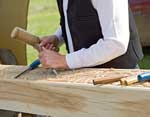If you have a hobby or pastime, do people often look at your work and say ‘that’s good – you could sell it’? If so, this article will show you how to market and promote yourself.
Many successful businesses started off as hobbies but now produce a full-time living for their owners. Whether you plan on building a multi-million dollar enterprise or just a bit of pin-money, the more effective at promoting and marketing you are, the more you can make.
First of all though, you will need to spend some money, but it doesn’t necessarily have to be a lot. It’s like buying the materials for your hobby – you need to invest to create.
So what marketing do you need? Think of it in three ways; Infrastructure, Reactive and Proactive.
Infrastructure. This is the minimum you need and could include business cards, labels for envelopes, packaging, letterheads for invoices and a website. Identify what could make your work appear as the output of a serious and professional micro-business.
Reactive. You want anyone actively searching for the things you make to be able to find you, and you need to be in those places. Look at how people buy – do they use Yellow Pages or online? Do they use other directories or see adverts? Is it craft fairs or recommendations from other people? It may be a combination of things or one in particular. Whatever it is, that’s where you need to be. For guidance on this, read Customer Purchasing Processes.
Proactive. Sales from Reactive purchases might give you all the sales you need or want. If not, you’ll need to seek prospective buyers. Think of Proactive activities like a tap, you can turn them on and do more if you have capacity or want to sell more, but pull back when you’re not available or have enough.
Proactive activities might involve craft fairs or car boot sales, or perhaps direct mail or advertising. Think about where potential buyers are likely to be found and target that place.
Have Infrastructure and Reactive items in place first before spending money on Proactive items. A little investment in quality Infrastructure and Reactive materials can go a long way so don’t skimp on it. Many designers and printers offer micro-business start-up packages providing everything needed for a fixed price. It’ll also look very professional.
Put your name, website address and telephone number on everything you produce so people can find you. Labels may be sufficient, or you may want to include a flyer or basic leaflet with anything you sell. If you do use a leaflet make sure it mentions your full product range and how to get in touch.
You can read more about the marketing items you might need in Essential Marketing Materials.
Attending Events
If you go to craft fairs, car boot sales or exhibitions, you’ll be in competition with lots of other stall-holders. It’s like having a shop front on a busy street, so you have to think about why people would want to visit your stall rather than someone else’s. You need to attract people to the stall where your work is displayed.
For a large event there may be a programme or directory to advertise in. You could also produce a banner or poster with which to decorate and promote your stall. If people see something that stands out from the crowd they will naturally wander over to see what it is, then they’ll browse your creations. You can read more about how to create an effective presence at Getting the Most From Exhibitions.
You could ask local craft or bric-a-brac shops to stock your goods. You may have to provide some samples on a ‘sale or return’ basis but you’ll soon find out if your work has general appeal or whether it should remain a hobby. If they do stock your goods it will get your name in the market. This is where your contact details and a basic website are vital, as people can then enquire further if they see items they like or want to purchase more.
One day you may be able to sell your prized creations over the internet – but that’s more expensive to set up and is the subject for another article.





